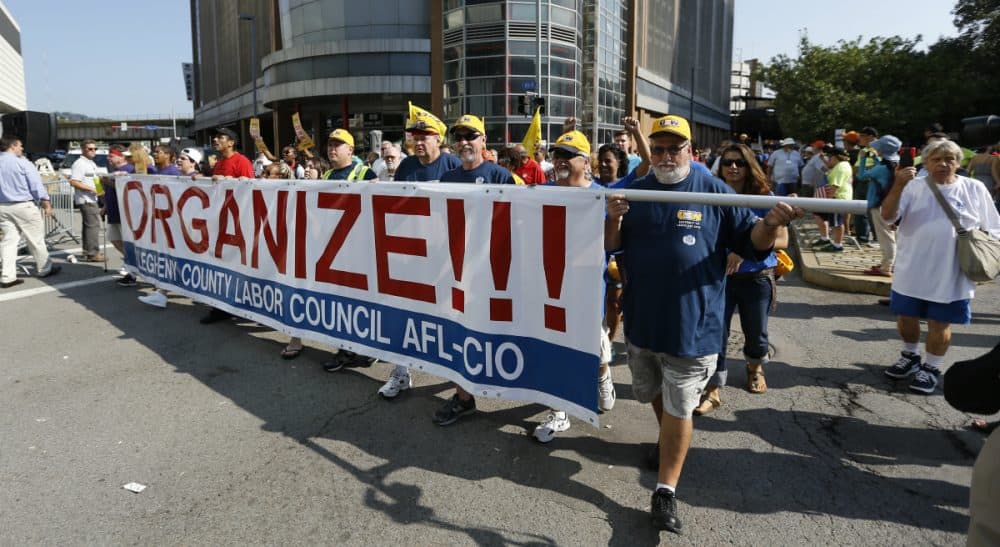Advertisement
Organized Labor's Challenge In 21st Century America

Republican candidates gathered recently in New Hampshire to vilify teacher unions, building on Scott Walker’s historic attack on public sector unions in Wisconsin. At the same time, Democratic candidates have been meeting with fast food workers, teachers and top-level union leaders and used Labor Day to demonstrate that they see unions as their ally in building a more broadly shared prosperity.
…the decline in unions accounts for between 20 and 30 percent of the rise in income inequality and stagnant wage growth experienced over the last several decades.
If some question the role of unions in America today, workers have not given up them. The most recent Gallup poll finds support for unions increased to 58 percent with the highest level (66 percent) of support coming from young workers. Other polls show that interest in joining a union has grown steadily over the years, from a low of 30 percent in the 1970s to nearly 50 percent today. Economic evidence shows that the decline in unions accounts for between 20 and 30 percent of the rise in income inequality and stagnant wage growth experienced over the last several decades. Large numbers of workers still want unions, and the economy has paid a steep price for their decline.
Yet many Americans remain skeptical of unions, reflecting on past labor management conflicts or unions’ resistance to change. So the question is: Can labor adapt to a changing workforce and economy and once again become the innovative force that helped build a strong middle class?
The answer is yes. Consider The Workers Lab, a labor incubator created by Service Employee Union leaders to foster new ways of representing workers, such as training programs that match technicians with employers in need of their skills; organizations that build coalitions with customers and restaurant owners to promote sustainable food practices and good jobs; an Internet service that helps workers mount petitions to expose unfair practices and call for change; and an organization that helps new immigrants assert their rights at work.
The nation’s largest labor federation, the AFL-CIO, has created a Young Workers’ group that has laid out a Common Sense economic agenda that emphasizes building a strong economy by rebuilding a prosperous middle class. It has also signed up more than 2 million members in a new advocacy organization called Working America, which provides education and networking in support of local and national political issues, and built coalitions with community groups seeking living wage ordinances, fighting wage theft and advocating for immigration reform.
Innovations in labor are taking place right here in Massachusetts, as well. The Massachusetts Education Partnership (MEP) is a joint effort of the state’s teachers unions, school superintendents, school boards associations and state education officials committed to working together to improve student performance and promote educational innovations. (Full disclosure: I was involved in its formation.) In the first two years, the MEP engaged nearly half of the state’s school districts and local teacher unions in joint efforts ranging from statewide conferences to formation of labor management teams to address such high priority issues as teacher evaluations, dual language curriculum design and professional development for young educators. In Boston, the MEP facilitated an historic agreement between the teachers union, the mayor and the school department to add the equivalent of a month to the school calendar. More than 40 district and union teams are now using Interest-Based-Bargaining in their contract negotiations. Superintendents, school board members and teacher union representatives see improvements in the ability of collective bargaining to contribute to school performance.
The role of unions is now front and center on the American political agenda.
As entrepreneurs use advances in information technology to build the sharing economy, enterprising workers use the same technologies to provide workers with the information they need to negotiate a fair share of the revenue they help create. Uber drivers use Sherpashare to calculate their hourly earnings after accounting for all their expenses. Users of Amazon’s Mechanical Turk, an online platform that posts coding and other IT jobs , have created Turk Opticon, an app that rates the trustworthiness of employers who post these jobs. These are just a small sampling of the innovations underway both within the labor movement and among new groups that are forming to give workers the voice they want at work and the bargaining power they need to turn the economy around.
The role of unions is now front and center on the American political agenda. Voters can send a clear signal about the labor and employment policy they want their next president to pursue. Let us hope that this debate will be informed by what workers want and what the economy needs from labor.
